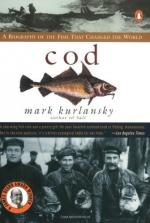
|
| Name: _________________________ | Period: ___________________ |
This test consists of 15 multiple choice questions and 5 short answer questions.
Multiple Choice Questions
1. What was the Iceland Coast Guard's secret weapon?
(a) A radio jammer.
(b) A trawl wire cutter.
(c) A linguistics expert.
(d) A fire hose.
2. What were thick rubber gloves with cotton lining that fishermen wore called?
(a) Skimmers.
(b) Mitts.
(c) Stiffs.
(d) Nippers.
3. Which mountain erupted in 1389 on Iceland?
(a) Mt. Askja.
(b) Mt. Esja.
(c) Mt. Hekla.
(d) Mt. Hvannadalshnúkur.
4. Who returned to Iceland in 1964 and was astounded by its transformation?
(a) Pablo Picasso.
(b) W. H. Auden.
(c) Henry David Thoreau.
(d) Erik Eriksson.
5. Hákarl is the flesh of a large _____.
(a) Greenland shark.
(b) Puffer fish.
(c) Gray skate.
(d) Hake.
6. Watertight ship holds with holes for circulating seawater to keep fish alive were called _____.
(a) Cod keepers.
(b) Keeper holds.
(c) Wet wells.
(d) Live cages.
7. A ship with onboard fish processing is called a _____.
(a) Floating station.
(b) Transport plant.
(c) Process outfitter.
(d) Factory ship.
8. In the quota system, groundfish are killed being hauled up do to _____.
(a) Pressure changes.
(b) Hypothermia.
(c) Oxygen depletion.
(d) Hyperthermia.
9. What does the Dutch word "schrode" mean?
(a) Chip.
(b) Strip.
(c) Stick.
(d) Fish.
10. One-third of the Iceland town of Heimaey was destroyed by _____ in 1973?
(a) Floods.
(b) A volcanic eruption.
(c) A fire.
(d) A hurricane.
11. Clarence Birdseye was passing the winter in _____ when he discovered how to freeze food.
(a) Alaska.
(b) Greenland.
(c) Iceland.
(d) Labrador.
12. Which schooner is now tied up as part of a maritime museum in Nova Scotia?
(a) The Halifax Fishherder.
(b) The Bluenose.
(c) The Theresa E. Connor.
(d) The Thomas S. Gorton.
13. Who were infamous on the Grand Banks for the harshness of their working conditions?
(a) The French.
(b) The British.
(c) The Portuguese.
(d) The Spanish.
14. Today, fish sticks are usually _____.
(a) Haddock.
(b) Pacific pollock.
(c) Pacific cod.
(d) Ling cod.
15. What were the French fishing fleets called?
(a) Bateaux Royales.
(b) Poisson de la Mer.
(c) Terre-Neuve.
(d) Jette-beaux.
Short Answer Questions
1. What 1901 convention establishing the three-mile limit was nullified in 1944?
2. Which British foreign secretary commented on the third Cod War saying that both sides have shown valor, but there was no need to show virility?
3. Equipment that waits for the fish is called _____.
4. According to the book, fishing is hardest on what part of the body?
5. What was the forerunner of sonar?
|
This section contains 378 words (approx. 2 pages at 300 words per page) |

|




